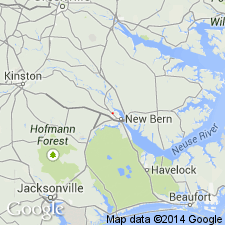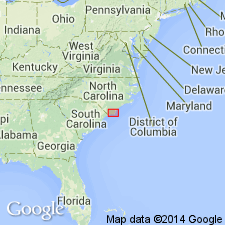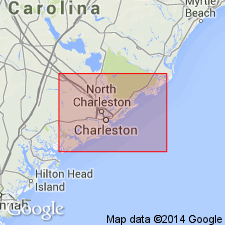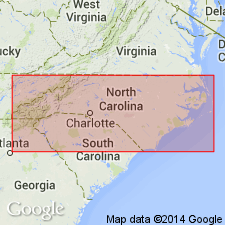
- Usage in publication:
-
- River Bend Formation*
- Modifications:
-
- Named
- Dominant lithology:
-
- Limestone
- AAPG geologic province:
-
- Atlantic Coast basin
Summary:
River Bend Formation here named in Craven Co., NC, to replace name Trent Marl (now abandoned). At type locality consists of 3 m of light- to medium-gray and grayish-orange arenaceous, fossiliferous limestone, including biocalcarenite, biocalcirudite, and shell hash. Thickness ranges from 3 to 150 m. Unit unconformably overlies Castle Hayne Formation and unconformably underlies Belgrade Formation (new) or Duplin Formation. Correlates with Byram Formation, upper beds of Cooper Formation, Suwannee Limestone, Chickasawhay Formation, and Paynes Hammock Sand. Age is middle and late Oligocene.
Source: GNU records (USGS DDS-6; Reston GNULEX).

- Usage in publication:
-
- River Bend Formation
- Modifications:
-
- Biostratigraphic dating
- AAPG geologic province:
-
- Atlantic Coast basin
Summary:
The lower part of the River Bend Formation at New Bern quarry in Craven Co., NC, contains diverse and abundant molluscan fauna which suggests a late Vicksburgian (NP21-NP22) or pre-Chickasawhayan (NP23) age for this unit and a subtropical, open-marine environment. Forty-one species and subspecies have been identified. The upper part of the River Bend, exposed near Belgrade, differs faunally, climatically, and sedimentologically from the lower River Bend. There the fauna suggests a cooler, nearshore environment. At the New Bern quarry, unit unconformably overlies the Spring Garden Member of the Eocene Castle Hayne Formation and unconformably underlies the Pliocene Yorktown Formation. Unit is probably equivalent to the Marianna and Glendon Limestones, and the Byram and Bucatunna Formations of MI.
Source: GNU records (USGS DDS-6; Reston GNULEX).

- Usage in publication:
-
- River Bend Formation
- Modifications:
-
- Areal extent
- Overview
- AAPG geologic province:
-
- Atlantic Coast basin
Summary:
Local distribution of the Oligocene River Bend is restricted to part of southern New Hanover Co. Preserved only in a shallow embayment in the underlying Castle Hayne. Thickness ranges from 10 to 24 ft with an average of 12 ft. Unit is a white, sandy and slightly glauconitic moldic limestone or a fine-grained, slightly shelly sandstone with traces of phosphate and glauconite. Sparse foraminifers includes the planktic GLOBIGERINA CIPEROENSIS and G. ANGIPORIDES and the benthic UVIGERINA TUMEYENSIS and TEXTULARIA MISSISSIPPIENSIS. Strata mapped as Oligocene in the subsurface of southern Brunswick Co. by Brown and others (1972) has proved to be instead Eocene Castle Hayne and Cretaceous Rocky Point Member of Peedee Formation.
Source: GNU records (USGS DDS-6; Reston GNULEX).

- Usage in publication:
-
- River Bend Formation
- Modifications:
-
- Not used
- AAPG geologic province:
-
- Atlantic Coast basin
Summary:
Oligocene and lower Miocene stratigraphic nomenclature in NC was revised almost simultaneously by Baum and others (1978) and Ward and others (1978). According to authors, recent studies indicate that neither interpretation is accurate and further revision is necessary. The interpretation presented here is based on a combination of the earlier revisions. River Bend Formation is not used. The lower River Bend is equivalent to the Trent Formation (early Oligocene Vicksburgian Stage--calcareous nannofossil zones NP21-22). The upper River Bend is equivalent to the Belgrade Formation of Baum and others (late Oligocene Chickasawhayan Gulf Coast Stage--calcareous nannofossil zones NP24-25).
Source: GNU records (USGS DDS-6; Reston GNULEX).

- Usage in publication:
-
- River Bend Formation
- Modifications:
-
- Geochronologic dating
- Age modified
- AAPG geologic province:
-
- Atlantic Coast basin
Summary:
The material analyzed in this study consisted of long-ranging, nondiagnostic fossil shells and sandy, glauconitic limestones. Phosphatic materials gave inconsistent results. The age of deposition for each unit was assigned by comparing 87Sr/86Sr results with the seawater strontium curve. According to this study, the River Bend was deposited during the middle Oligocene and does not extend into the late Oligocene as suggested by Ward and others, (1978).
Source: GNU records (USGS DDS-6; Reston GNULEX).
For more information, please contact Nancy Stamm, Geologic Names Committee Secretary.
Asterisk (*) indicates published by U.S. Geological Survey authors.
"No current usage" (†) implies that a name has been abandoned or has fallen into disuse. Former usage and, if known, replacement name given in parentheses ( ).
Slash (/) indicates name conflicts with nomenclatural guidelines (CSN, 1933; ACSN, 1961, 1970; NACSN, 1983, 2005, 2021). May be explained within brackets ([ ]).

